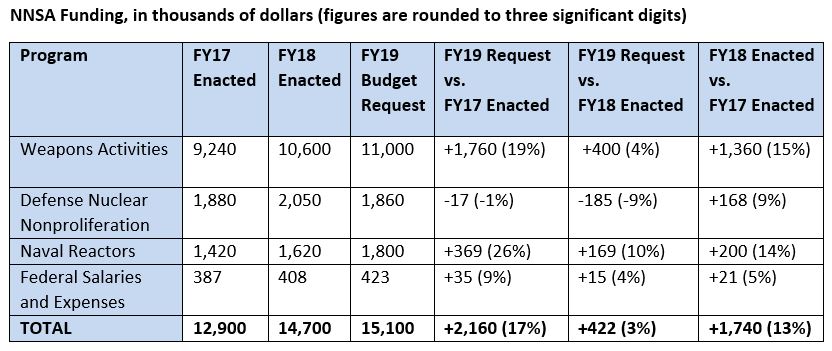In late February the Department of Energy (DOE) released its FY2019 budget request for the National Nuclear Security Administration (NNSA), and in late March Congress passed its final FY2018 appropriations bill, so we now have more information about the agency’s plans for the next several years. To no one’s surprise, both the administration and Congress increased funding for the NNSA and, in particular, for its nuclear weapons work.

(Source: free pictures of money)
Meanwhile funding for Defense Nuclear Nonproliferation—the category that covers programs to secure nuclear materials, detect illicit activities, and provide technical support for arms control measures—was down slightly in the request, but Congress added funds in this category, so the final appropriation actually shows a slight increase.
The administration requested a total of $15.1 billion for the NNSA, with $11 billion of this devoted to nuclear weapons (listed as “Weapons Activities”). This is an increase in overall NNSA funding of roughly $2 billion (17%) over the FY2017 enacted budget and $422,000 (3%) over the FY2018 enacted budget. The increase in Weapons Activities funding is sharper, an additional $1.8 billion (19%) from FY17 and $375,000 (4%) from FY18. Defense Nuclear Nonproliferation, on the other hand, saw a slight decrease in the budget request vs. previous year’s funding. The administration’s request included $1.86 billion for Defense Nuclear Nonproliferation, down from $1.9 billion in FY2018. Congress, however, increased this funding to $2.05 billion, a small increase from both FY2018 and the FY2017 enacted budget of $1.9 billion.
Table 1 lays out the progression of funding so far, and a few of the more notable changes are discussed below, but for an overview of the latest funding moves, good summaries are available in this short but thorough piece from the American Institute of Physics (though note that it was published before information about the W76-2 funding—discussed below—came out), and this more comprehensive summary from the Congressional Research Service focuses on appropriations for the NNSA’s Weapons Activities category.

Table 1.
Low-Yield Nuclear Weapons
Both the budget request and appropriations legislation are in line with the administration’s increased emphasis on the importance of nuclear weapons to US security, a view that is very clear in its recently released Nuclear Posture Review. The Trump administration claims that the US needs to modernize and expand its nuclear arsenal to respond to what it states are increased threats from Russia and others. One way it seeks to do this is by building new “low-yield” nuclear weapons, which it says are needed to increase the flexibility of US responses and thus increase deterrence. In particular, it is planning to produce a new warhead for the sub-based Trident missiles, the so-called W76-2, with a reported yield of 6.5 kilotons. (For comparison, the two warhead types now carried by subs have yields of 100 and 455 kT, and the bomb that destroyed Hiroshima had a yield of about 15 kT.) However, the US already has bombs and air-launched cruise missiles with variable yields—including some as low as 0.3 kT. Adding another type of low-yield nuclear weapon is provocative.
Although the budget request and appropriations legislation did not include any NNSA funding for the W76-2, an Office of Management and Budget amendment to the FY19 budget request submitted on April 13 does provide $65 million for work on the W76-2 (see p. 44). This money is reallocated from elsewhere in the Weapons Activities category and, when added to Department of Defense funds, brings the total funding for the modified warhead to $87.6 million in FY2019. The amendment also indicates that the administration plans to begin working on the modified warhead in FY2019, before the W76-1 life extension program ends and the associated production line closes.
Mixed-Oxide Fuel (MOX)
As my colleague Ed Lyman has already reported, another notable change in the latest legislation is that it moved one step closer to finally ending the expensive and dangerous Mixed Oxide Fuel (MOX) program. The FY2019 appropriations legislation cleared the way for the Department of Energy to shift to an alternative approach, “dilute and dispose,” that is both cheaper and has fewer security risks, and DOE has now taken the necessary step to make this change.
The MOX program was designed to dispose of excess plutonium from the US nuclear weapons program by turning it into fuel for nuclear power reactors. However, the project is decades behind schedule and cost estimates have climbed to more than $50 billion—ten times its original projected cost. The FY2019 appropriations legislation provided that if DOE submitted to Congress a life-cycle cost estimate showing that there is an alternative approach to MOX that would cost less than half the remaining MOX program cost, it would be allowed to terminate the MOX program. DOE submitted this report in mid-May, finally making it possible to kill the program, which has been on life support for years.
